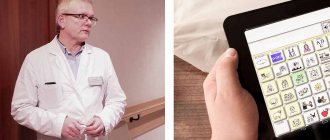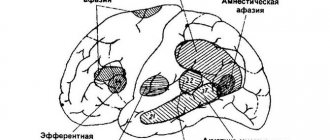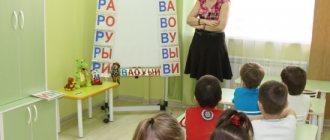- home
- Services and prices
- Neurology
- Restoring speech after a stroke
A stroke is an acute disruption of the blood supply to the brain, when cells in the nerve centers die from a lack of oxygen and neural connections are destroyed. Its consequences can be very different: memory loss, partial or complete paralysis, dementia and speech disorders. The latter are classified into several types: light, medium and heavy.
However, the results of a stroke are not irreversible: in most cases, it is possible to return the victim to normal life with the help of a set of rehabilitation measures.
Signs of speech impairment
The fact that the areas of the brain responsible for speech were damaged during a stroke is indicated by the behavior of the victim:
- The patient confuses words and sounds, stumbles, stutters;
- The construction of sentences is disrupted - instead of “I went to the street,” a person can say “I went to the street,” etc.;
- Frequent repetition of the same sounds or words;
- The patient does not understand well what is being said to him, forgets the names of objects;
- Consistent counting skills are impaired;
- Obscene words and expressions appeared.
The last factor often comes as a surprise, since after a stroke even cultured and well-mannered people can begin to swear. Experts say that this is due to the ancient origin of obscene language.
Causes
Amnestic aphasia is usually observed when the white matter is damaged at the junction of the parietal, occipital and temporal parts of the left or right hemisphere of the brain. It is important to note that the disease does not appear on the affected side, but on the opposite side. In left-handers, the right hemisphere is damaged, and in right-handers, the left. The main etiological reasons are the following factors:
- Traumatic damage to the above-described areas of the brain. Most often this occurs during road traffic accidents and blunt blows to the temporal region of the head with a heavy object. In this case, a rupture of axonal connections of the white matter of the brain of a traumatic nature may form.
- Surgical interventions on brain structures. Damage to neighboring brain structures cannot be ruled out, since anatomically all zones and regions of the brain are closely connected.
- Infectious and inflammatory diseases such as meningitis, encephalitis and brain abscess. Infectious diseases can be of viral or bacterial etiology and often lead to generalized brain damage.
- Neoplasms of a benign or malignant nature.
- Acute and chronic cerebrovascular accidents causing stroke, thrombosis of cerebral vessels or discirculatory encephalopathy.
- Acute intoxication of the body, especially with neurotoxic poisons, or as a result of an overdose of certain medications.
- Separately, lesions of nervous tissue are distinguished in acute renal or liver failure. In this form, metabolic and breakdown products are not removed from the body in a timely manner and lead first to dysfunctional disorders and then to organic damage to brain tissue.
- Mental illnesses.
- Alzheimer's disease and Pick's disease. In Alzheimer's disease, a combination of sensory aphasia with amnestic aphasia is often characteristic, and in Pick's disease, a combination with motor aphasia is more often observed.
There are several risk groups for amnestic aphasia:
- Genetic predisposition. If there are relatives in the family with similar diseases, then the hereditary history is burdened and significantly increases the risk of aphasia for the reasons described above.
- Elderly and senile age. Common extragenital diseases: coronary heart disease, hypertension, epileptic seizures or cluster headache.
Types of speech disorders
Modern medicine knows two main types of speech disorders after a stroke: aphasia and dysarthria. In the first case, speech is impaired due to the death of neurons and their connections in the brain center that is responsible for speech. Aphasia can be complete or partial. Dysarthria occurs against the background of the fact that the centers in the brain responsible for the functioning of speech muscles have been damaged.
Aphasia
It is the most common cause of speech impairment. There are six variations of aphasia in total:
- Motor
. This form is divided into two more types of aphasia. With afferent aphasia, the patient cannot choose the articulatory posture that is needed in order to pronounce specific sounds. With efferent aphasia, speech is preserved at an instinctive level, but repetition is impaired. Victims have difficulty moving from one position to another. - Dynamic
. In this variant, patients experience problems with active utterance: the inability to correctly formulate a sentence because both external and internal speech are impaired. There are frequent cases of echopraxia - repetition - situations when the patient automatically begins to repeat words, phrases, facial expressions or gestures after the interlocutor. - Sensory
. It is divided into three types: cortical, subcortical and transcortical aphasia. In the first case, the patient lacks both understanding and pronunciation of sounds; in the second, the transmission of impulses from the parts of the brain responsible for the perception of sound information is distorted. In the third case, writing and visual function are impaired, but the patient is capable of perceiving light speech structures. - Sematic
. The victims do not fully understand the complex speech structures that are responsible for spatial relationships. Problems are often observed when completing tasks that contain complex syntactic formulations. Patients forget the names of the simplest household items - dishes, furniture, clothing, electrical appliances, and read slowly. Sometimes acalculia develops, a neuropsychological disease when a person loses the ability to count consistently. - Acoustic-mnestic
. With this aphasia, patients experience difficulties that are associated with the ability to retain information perceived auditorily in memory. During classes with a speech therapist, patients cannot repeat the simplest connections of several words, or understand the meaning of a sentence when it is pronounced at a fast pace or during a conversation with several interlocutors. - Total
. A distinctive feature of this type of aphasia is the complete absence of speech due to damage to a large number of areas of the brain. Total aphasia is subject to hard and long-term correction work from various specialists - from massage therapists to speech therapists.
Dysarthria
A type of speech disorder when a stroke victim has impaired functioning of the organs responsible for articulation (tongue, palate, lips). It is observed much less frequently than aphasia and develops, as a rule, with damage to various brain structures, in particular the cranial nerves involved in the work of speech muscles. Patients experience sluggish and uncertain speech, and difficulty pronouncing individual sounds or words.
Articulatory dyspraxia
Another type of speech impairment is the inability of a person to make consistent movements with the mouth, lips, and tongue - which is divided into two types: kinetic and kinesthetic.
In the first option, difficulties arise when sequentially changing sounds and syllables, skipping them, replacing one syllable or sound with another, and incorrect placement of stresses.
In the second option, disturbances occur in the articulatory structure: the brain experiences difficulty interacting with the muscles responsible for producing sounds.
The formation of motor skills is carried out through adequately coordinated actions. After a stroke, neuronal death can occur in areas of the brain with the premotor, profrontal and motor cortices, which can lead to dyspraxia.
The correction of dyspraxia is carried out by a speech therapist in collaboration with a neurologist and psychologist.
Signs and causes of sensory aphasia
Sensory aphasia can result from a wide range of causes. This disease can be caused by both diseases of the cardiovascular system and traumatic injuries to the head and central nervous system. The most common causes of sensory aphasia are:
- Acute and transient disorders of cerebral blood flow, for example, embolism or hemorrhagic stroke. Embolization can occur as a result of the presence of an unstable atherosclerotic plaque in the bed of one of the carotid arteries or as a result of thrombus entry from the left atrial appendage in arthimogenic conditions.
- Traumatic head injuries, most often occurring in transport accidents. Contusions and traumatic brain injuries can lead to immediate damage to cortical and subcortical structures or delayed damage with the development of cerebral edema.
- Oncological processes localized in the cranium. Benign or malignant tumors can be a significant factor in the development of sensory aphasia.
It is important to note that the following branches entering the middle cerebral artery basin are most often involved in the formation of the lesion:
- Inferior branch of the middle cerebral artery;
- Posterior temporal artery;
- Artery of the angular gyrus.
Ways to restore speech after a stroke
Speech after a stroke is rehabilitated through a set of various measures. This includes taking medications that improve blood circulation and promotes the formation of new neural connections, and physical therapy, massage, speech therapy and articulation exercises, and much more. A plan for speech restoration after a stroke for a particular patient is developed individually based on research and the diagnosis made. Some aspects of rehabilitation therapy require specialist supervision, but not all of them. The patient can perform some exercises to restore speech after a stroke with the help and participation of people close to him, which will make the recovery process more effective.
As soon as the patient's condition has stabilized, the very first exercises begin. The patient is examined by a speech therapist and a neurologist. Special tests help identify existing problems and prescribe further treatment.
There are no guarantees that a person will fully restore speech skills: much depends on how severe the brain damage was, on the body’s ability to regenerate and the interest of the patient and his loved ones in achieving the goal.
It is strictly not recommended to self-medicate and teach the patient to talk on his own. There is a risk of developing complications in the form of echolalia - meaningless repetition of words, verbal embolus, agrammatism, etc. A set of treatment measures is prescribed exclusively by a group of treating specialists.
Speech therapy exercises
Regular sessions with a speech therapist are the key to speech restoration. At first, the specialist works with the patient himself, then relatives can continue training at home.
The basis of a speech therapist’s work is the involvement of certain parts of the brain in the control of speech functions. To do this, he uses different techniques and sets of exercises:
- Phonetic. Through the victim repeating individual sounds, words and phrases after the doctor, the type of speech disorder is determined. The facial muscles of the tongue and lips are under control.
- Semantic. The active thought process is stimulated. A person who has suffered a stroke must complete sentences, series of associations, and talk on various topics.
- Visual. The use of cards with images, book illustrations and other specialized items so that the patient begins to build various connections and associative series. This method is usually used for sensory aphasia.
- Creative. Various types of creative activities are included in the rehabilitation work, in particular those that the patient was interested in. This could be expressive reading of tongue twisters, poetry, acting, music, singing, drawing, etc.
There are several rules for completing tasks:
- Gradually increasing the complexity of the exercises;
- Encouragement of the patient's achievements is mandatory;
- Monitor the patient’s condition and prevent overwork;
- Number of classes – no more than 5-10 per week.
Based on the patient’s progress, the speech therapist should adjust the rehabilitation program from time to time.
Massage
After a stroke, there are often cases of not only speech impairment, but also the appearance of problems with the speech apparatus: in patients, chewing function is impaired, uncontrolled salivation appears, and the corners of the mouth and cheeks sag. There is a need to restore muscle tone and start the process of restoring correct facial expressions. Here a special massage comes to the aid of the patient, which is prescribed by the attending physician depending on the characteristics of the injury in a particular person.
The main objectives of massage within the framework of rehabilitation therapy are:
- Improving blood circulation and activating lymph outflow;
- Normalizing the tone and elasticity of muscle tissue;
- Strengthening the general condition of the body;
- Relieving tension and anxiety in patients.
Massage is prescribed almost immediately after the patient’s condition has stabilized: approximately one to two weeks after the crisis. At first, these are simple stroking of the muscles and gentle rubbing at a moderate rhythm. Then the techniques become more complex, kneading and vibration are used, the intensity and duration of the sessions increases.
The decision to prescribe or refuse massage courses is made by the attending physician. Sometimes a patient may have contraindications to it, an increased risk of developing severe deviations from the norm of body functionality, and other complications.
Articulation exercises
This type of exercise is used to increase control over the muscles involved in speaking.
Speech therapy exercises that develop language:
- Stick it out and hold it in this position for a few seconds;
- Try to reach your nose with your tongue and hold it;
- Pass it from one corner of the mouth to the other several times;
- Move your tongue back and forth across the palate;
- Clatter;
- Lightly bite your tongue after relaxing it;
- Trace your lips first counterclockwise and then clockwise.
Exercises to develop lips:
- Fold them into a tube and pull them out;
- Smile with your mouth closed;
- Raise your lip up, showing the upper row of teeth;
- Roll the air in different directions, inflating first one or the other cheek;
- Blow through your lips, having previously relaxed them;
- Use your fingers to pull them up, down, right, left;
- Alternate between raised and lowered corners of the mouth.
Exercises to restore your voice:
- Alternate pronunciation of vowels;
- Silent articulation of “Y”;
- Pronunciation of vowels one after another with a smooth transition of sound, while reversing stress;
- Repetition of consonant sounds - from voiceless to voiced.
Exercises for facial expressions:
- Working with eyebrows: frowning, being surprised with their help;
- Open very wide and then relax your mouth;
- “Kiss” the air;
- Stick your tongue out to your interlocutor and pull him in different directions;
- Move your jaw.
Depending on the type of disease, the doctor selects an individual set of tasks for each patient.
Breathing exercises
Classes with a speech therapist will be many times more effective if, before starting speech exercises, you perform physical exercises that will improve articulation and function of the facial muscles:
- Pull the letter “U” through the elongated “tube” lips;
- Smile several times so that symmetry is maintained at the corners of the lips;
- If the loss of sensitivity is insignificant, slightly bite the lower and then the upper lip;
- Roll up your tongue;
- Smack expressively;
- Run your tongue over your lips and palate;
- Calmly inflate and deflate your cheeks.
To achieve positive dynamics, exercises must be performed regularly.
Drug therapy
Taking medications in the post-stroke period allows you to prevent the process of cell destruction, normalize blood circulation and start the process of tissue regeneration.
Experts prescribe different types of drugs:
- Blood thinners – medications that reduce blood viscosity and stimulate improved blood circulation;
- Diuretics – relieve swelling, including in the brain;
- Nootropic drugs – stimulate the regeneration of nerve cells;
- Antihypertensive drugs – do not allow blood pressure to reach a critical value, which can cause complications.
Music therapy
In certain situations, when the patient does not speak at all, but can sing, treatment with music helps. All exercises with a speech therapist in such a situation involve singing: the patient sings sounds, words, sentences, repeats the words and motive after his favorite performer.
In addition, music has a positive effect on the human psyche, calming or making him happy. Often patients are in a state of depression or increased anxiety, and here music comes to the aid of specialists, which stabilizes the emotional background.
The positive effect of music on brain recovery after a stroke was studied in scientific workshops. During classes, people with speech impairments had their cerebral cortex activity measured. It has been proven that music stimulates the functioning of the nervous system, promotes the formation of new neural connections, and therefore restores brain properties lost during the disease.
Physiotherapy
A set of therapeutic practices and techniques for stimulating the articulatory apparatus and vocal cords by exposure to electrical impulses, magnetic radiation, light, heat or air, ultrasound, etc.
Some of the main goals of physiotherapy after a stroke are:
- Prevention of complications and new stroke;
- Improving blood circulation and metabolism;
- Preventing the occurrence of blood clots, which can lead to blockage of blood vessels;
- Restoration of muscle tone;
- Relieving pain and swelling;
- Improving the passage of nerve impulses, accelerating the formation of new neurons;
- Normalization of sleep patterns and general well-being of the patient.
Acupuncture
A popular procedure is used to correct motor aphasia and helps restore the tone of the speech apparatus.
The effectiveness of acupuncture has long been proven by science: needles irritate nerve endings in the skin, send signals to the brain and spinal cord, thereby activating the central nervous system and promoting the formation of new neurons. Also, when using this method, muscle activity improves, pain decreases, and the immune system is activated.
Traditional methods
Treatment of stroke with herbs is sometimes practiced by some doctors, prescribing it as an auxiliary therapy. Taking decoctions of viburnum, thyme, St. John's wort, rose hips, and calendula, of course, can help improve blood circulation or increase the body's overall resistance, but it is not a panacea.
We do not recommend starting treatment of relatives who have suffered from a stroke on their own using traditional methods: first consult with your doctor and make sure that the patient is not allergic to this or that drug.
MOTOR APHASIA OF AFFERENT TYPE
Stage of severe disorders
1. Overcoming disorders of understanding situational and everyday speech:
- display of pictures and real images of the most commonly used objects and simple actions by their names, categorical and other characteristics. For example: “Show a table, a cup, a dog, etc.”, “Show pieces of furniture, clothing, transport, etc.” “Show someone who flies, who talks, who sings, who has a tail, etc.”
— classification of words by topic (for example: “Clothing”, “Furniture”, etc.) based on a subject picture;
— answers with an affirmative or negative gesture to simple situational questions. For example, “Is it winter now, summer..?”; "You live in Moscow?" and etc.
2. Disinhibition of the pronunciation side of speech:
- conjugate, reflected and independent pronunciation of automated speech series (ordinal counting, days of the week, months in order, singing with words, ending proverbs and phrases with a “hard” context), modeling situations that stimulate the pronunciation of onomatopoeic pronouns (“ah!” “oh” !" and so on.);
- conjugate and reflected pronunciation of simple words and phrases;
- inhibition of the speech embolus by introducing it into a word (ta, ta..-Tata, so), or into a phrase (ma..ma-mama...; this is mom).
3. Stimulating simple communicative types of speech:
— answers to questions in one or two words in a simple situational dialogue;
— modeling situations that contribute to the evocation of communicatively significant words (yes, no, want, will, etc.);
— answers to situational questions and composing simple phrases using a pictogram and a gesture accompanied by the pronunciation of simple words and phrases.
4. Stimulating global reading and writing:
— laying out captions under pictures (subject and subject);
- writing the most common words-ideograms, copying simple texts;
— conjugate reading of simple dialogues.
Moderate stage of disorders
1. Overcoming disorders of the pronunciation side of speech:
- isolating sounds from words;
— automation of individual articles in words with different syllabic structures;
— overcoming literal paraphasias by selecting first discrete and then gradually converging sounds in articulation.
2. Restoration and correction of phrasal speech:
- composing phrases based on a plot picture: from simple models (subject-predicate, subject-predicate-object) to more complex ones, including objects with prepositions, negative words, etc.;
- composing phrases on questions, on key words;
- exteriorization of grammatical-semantic connections of the predicate: “who?”, “why?”, “when?”, “where?” etc.;
— filling in gaps in a phrase with a grammatical change in a word;
— detailed answers to questions;
- compiling stories based on a series of plot pictures;
- retelling texts based on questions.
3. Work on the semantics of the word:
— development of generalized concepts;
- semantic play on words (subject and verbal vocabulary) by including them in various semantic contexts;
— filling in the gaps in a phrase;
- completing sentences with different words that are appropriate in meaning;
- selection of antonyms, synonyms.
4. Restoration of analytical-synthetic writing and reading:
- the sound-letter composition of the word, its analysis (one-two-three-syllable words) based on diagrams that convey the syllabic and sound-letter structure of the word, a gradual reduction in the number of external supports;
- filling in missing letters and syllables in words;
- copying words, phrases and small texts with an emphasis on self-control and independent error correction;>
- reading and writing from dictation of words with a gradually more complex sound structure, simple phrases, as well as individual syllables and letters;
- filling in missing words in texts when reading and writing, practiced in oral speech.
Stage of mild disorders
1. Further correction of the pronunciation aspect of speech:
— clarification with articles of individual sounds, especially affricates and diphthongs;
— differentiation of acoustic and kinesthetic images that are similar in articulation of sounds in order to eliminate literal paraphasias;
- practicing the purity of pronunciation of individual sounds in a sound stream, in phrases, with a combination of consonant sounds, in tongue twisters, etc.
2. Formation of detailed speech, complicated in semantic and syntactic structure:
- filling in the missing main sentence, as well as a subordinate sentence or subordinating conjunction in a complex sentence;
- answering questions with complex sentences;
- retelling texts without relying on questions;
— drawing up detailed plans for texts;
— preparation of thematic messages (short reports);
- speech improvisations on a given topic.
3. Further work to restore the semantic structure of the word:
- interpretation of individual words, mainly with abstract meaning;
— explanation of homonyms, metaphors, proverbs, phraseological units.
4. Work on understanding complex logical and grammatical figures of speech:
— execution of instructions, including logical and grammatical phrases;
— introduction of additional words, pictures, questions that facilitate the perception of complex speech structures.
5. Further restoration of reading and writing:
- reading and retelling expanded texts;
- dictations;
— written presentation of texts;
— writing letters, greeting cards, etc.;
- essays on a given topic.
1) Restoring the “articuleme-phoneme” connection
- writing letters corresponding to the names of sounds in expressive speech, reading these letters immediately after writing;
- isolating the first sound from simple words, fixing attention on the articulatory, acoustic, and then graphic image of this sound; independent selection of words for this sound and writing them;
- writing practiced sounds and syllables under dictation;
— identification of letters in different fonts;
— finding given letters in various texts (underlining, writing out).
2) Restoring the ability to sound-letter analysis of the composition of a word:
- dividing words into syllables, syllables into letters (sounds) based on various graphic schemes;
- highlighting any sound in a word;
- recalculation and listing of words by letter (orally);
- filling in gaps in words;
- writing words from letters given separately.
3) Restoring the skill of detailed written speech:
- writing words of different sound structures with and without support from an object picture: a) under dictation, b) when naming an object or action;
- writing proposals: a) from memory, b) from dictation, c) in the form of a written statement based on a plot picture for the purpose of communication with others;
- written statements and essays.
How long does it take to restore speech after a stroke?
The rehabilitation process usually takes from several months to several years - it all depends on whether the speech centers were severely damaged. Common disturbances in aphasia disappear on average 3-6 months after the crisis.
If the stroke was suffered in a severe form, then the possibility of restoring lost speech skills is about 55%. With moderate severity, it is guaranteed that 75% of the damage can be restored, with mild damage – up to 90%.
The most favorable prognosis is observed in patients who have suffered motor aphasia. In young people, speech is restored almost completely; in older people, minor impairments may remain in the form of unclear pronunciation of individual sounds.
Forms of sensory aphasia
There are several significant clinical forms of sensory aphasia that are characteristic of sensory aphasia. When additional pathological foci of the cortical substance join the affected Wernicke's area, new symptoms of impaired speech function appear. In this regard, neurologists distinguish the following forms of aphasia:
Semantic aphasia
With this aphasia, there is a violation of the recognition of logic and the relationship of words and objects. This is especially true for spatial perception.
Acalculia-aphasia
In this case, the key symptom is the formation of a localized disorder of speech function. Namely, counting violations. At the same time, the patient’s other forms of speech are not affected.
Sensorimotor aphasia
Lack of speech awareness is associated not only with damage to the cortical part of the auditory analyzer, but also with a violation of articulatory function. In other words, a person cannot correctly evaluate gestures when pronouncing a specific word like another person. Same with myself. The patient himself is not aware of his illness and is very irritated in situations where he is not understood.
Total aphasia
With this option, the victim has a combination of different types of functional speech disorder. The patient has impairments in written and oral speech. In this case, the patient does not perceive someone else’s speech and also cannot answer anything himself.
Where is the best place to go for rehabilitation?
The very first actions to regain lost skills begin in a hospital setting. The attending physician develops a treatment strategy and prescribes medications that help accelerate the regeneration of brain cells.
Speech restoration after a stroke is carried out both at home and in special rehabilitation centers in Moscow, where qualified speech therapists-aphasiologists, neurologists, psychologists, and massage therapists work with victims.
The patient is first examined and, based on the diagnostic results, a rehabilitation program is prescribed, which allows the person to gradually return to a normal, fulfilling life. Individual consultations are held with the patient’s family and friends and sets of exercises are prescribed, which will need to be continued to be practiced at home.
Diagnostics
Diagnosis of sensory aphasia is primarily aimed at identifying the cause of the disease. The diagnostic study must be comprehensive and consist of the following stages:
- Consultation and questioning of the patient to determine the history of life and illness. Also, during the initial appointment, the doctor examines the patient and studies specific symptom complexes. The neurologist looks for concomitant diseases that manifest themselves not only by external signs, but also by conducting additional tests and studies. During the examination, a specialist neurologist determines the lesions, the nature and course of the pathological process, assesses the general condition of the patient, as well as the blood supply to the brain. Makes a prognosis and subsequent treatment plan in accordance with the patient’s age. Its individual characteristics and concomitant somatic diseases. As well as the level of damage to the central nervous system.
- Consultation with a speech therapist, psychologist and other specialists. They determine the severity of the speech function defect and coordinate further tactics for restoring lost functions with the attending physician.
- Conducting additional instrumental and laboratory studies to verify and clarify the clinical diagnosis. Studies such as computer and magnetic resonance imaging, electroencephalography, angiography of cerebral vessels are carried out. These studies are carried out to identify the level and area of brain damage, the presence of space-occupying formations in the nervous tissue, aneurysms and hemorrhages in the brain tissue, foci of abscess, and the consequences of a stroke.
Treatment
Treatment of amnestic-semantic aphasia must be comprehensive. In this case, one should not hesitate, since the sooner corrective measures are started, the greater the patient’s chances of restoring lost cognitive functions.
After a diagnostic examination and clarification of the severity of damage to the speech centers of the brain, specialists formulate an individual treatment plan. In drawing up a treatment plan, in addition to functional and organic disorders, the patient’s age and mental state play an important role. Both a neurologist and a psychotherapist must work with each patient to achieve maximum effectiveness from therapy. If a serious organic pathology is detected that requires immediate surgical treatment, for example, in case of brain injuries or tumor lesions, emergency or planned surgical intervention is performed to eliminate the life-threatening condition and minimize cognitive impairment in the future.






